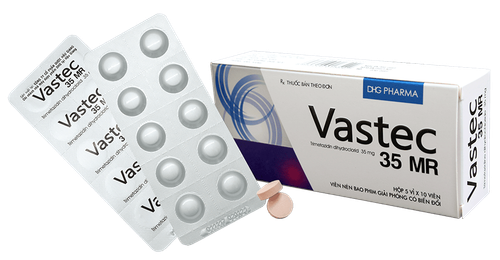This is an automatically translated article.
Flamodip is a prescription medication used to treat conditions such as high blood pressure, angina, or ischemic heart disease. During the course of treatment with Flamedip, patients need to follow the instructions of the specialist to get rid of the disease soon.1. What is Flamodip?
Flamodip belongs to the group of cardiovascular drugs, used mainly in cases of hypertension or myocardial ischemia accompanied by stable angina pectoris. Flamedip drug originated from India and is now widely circulated in Vietnam.
Flamedip drug is prepared in the form of tablets, each box includes 10 blisters x 10 tablets. The main ingredient in each Flamodip tablet is Amlodipine 5mg. In addition, the manufacturer also adds a number of other auxiliary excipients to increase the pharmacokinetic and pharmacodynamic properties of the main active ingredient.
Currently, Flamodip is only used with a doctor's prescription. Therefore, patients should avoid self-medication without consulting the medical person in charge.
2. What are the effects of Flamedip?
2.1. Uses of the active ingredient Amlodipine
Amlodipine in the drug Flamodip acts as a calcium antagonist of the Dihydropyridine class. This active ingredient has the ability to inhibit the influx of calcium across the membrane into cardiac muscle cells as well as the smooth muscle of the blood vessel wall through the effect of blocking slow calcium channels of the cell membrane. This also helps to reduce the smooth muscle tone of the blood vessels, thereby helping to reduce the peripheral resistance associated with hypotension.
According to research, the active ingredient Amlodipine has an effective antispasmodic effect thanks to the mechanism of dilating the peripheral arterioles, and at the same time reducing the cardiac afterload. On the other hand, Amlodipine also does not cause reflex tachycardia, thereby reducing myocardial energy and oxygen demand. In addition, the vasodilating effect of the coronary vessels (including arterioles and arteries) in the ischemic and normal regions of the active ingredient Amlodipine also helps to increase the oxygen supply to the myocardium.
2.2. Indications – Contraindications to the use of Flamedip
Flamedip is prescribed by doctors to treat some of the following health conditions:
Monotherapy for high blood pressure. In case of necessity, Flamodip can be combined with beta-blockers, thiazide diuretics or ACE inhibitors to increase the therapeutic effect. Treatment of stable angina, myocardial infarction or vasomotor angina. Consider Flamodip monotherapy or in combination with other antianginal agents to increase the effectiveness of treatment. In addition, the doctor may prescribe Flamodip for patients who are resistant to beta-blockers or nitrates. However, not every patient with hypertension, angina or myocardial infarction can be treated with Flamedip. Here are some cases where patients are contraindicated to use Flamodip as recommended by their doctor:
People who are allergic or have a history of hypersensitivity to the active ingredient Amlodipine or any auxiliary excipients included in the drug formula . Patients with hypersensitivity to dihydropyridine derivatives. Flamodip is contraindicated in pediatric patients because there has not been adequate research on the safety and effectiveness of the drug for this population. Relative contraindications to the drug Flamodip for pregnant women or nursing mothers.
3. Specific instructions on the use and dosage of the drug Flamedip
Flamodip is made in the form of tablets for oral use. Patients should take the drug with a full glass of water (about 250ml), avoid drinking with other liquids such as carbonated water, soft drinks, coffee or alcohol.
In general, the duration of using Flamodip will be based on the doctor's assessment of the patient's health condition. Normally, Flamodip will be used at the following general recommended dosages:
Adults: Take 5mg/time/day (equivalent to 1 tablet), the dose may be increased to 10mg/day if the patient does not respond. after about 2 weeks of treatment. Elderly and cirrhotic patients: The dose of Flamodip should be adjusted according to the doctor's prescription. Before using Flamodip, you need to carefully read the instructions for use listed in the application leaflet that comes with the product or follow all the advice of your doctor. Absolutely do not arbitrarily apply, increase / decrease the dose or prolong the time of taking the drug without discussing with the doctor.
4. What side effects does Flamedip cause to users?
Besides the effects of treating high blood pressure, chest pain and myocardial infarction, Flamodip can sometimes cause some adverse reactions to patients during use, including:
Edema flushing due to vasodilation, usually mild to moderate. Tiny little. Cramp. Nocturia. Feeling useless. A cough. Asthma. Worried. Epistaxis . Conjunctivitis . Most of the side effects caused by Flamodip are mild and go away once the patient stops taking the drug. However, in certain cases, rare symptoms can become more severe if the person is detected and treated late. Ideally, if there are any strange reactions on the body after using Flamodip, the patient should immediately notify the doctor for a solution.
5. What precautions should be taken while using Flamedip?
In order to ensure safety and early effectiveness, patients should note the following general recommendations during treatment with Flamodip:
Flamodip should only be used during pregnancy and lactation in the face The potential benefits of the drug outweigh the potential harm. The time to peak plasma concentrations is similar in young and elderly subjects. In elderly patients, the clearance of the active substance Amlodipine tends to decrease with an increase in the half-life and AUC. The dose of Amlodipine for both young and elderly patients is the same when tolerability is similar. The same dose of Flamodip can be used for the elderly and people with heart failure. Patients with impaired liver function often have a prolonged half-life. Therefore, caution should be exercised when using Flamedip for this audience. Normal doses can be used in patients with renal impairment because the active substance Amlodipine is metabolized mainly in the liver to inactive metabolites, with only about 10% of the drug in the unchanged form being eliminated via the urinary tract. urine. Amlodipine is not dialyzable, so this method should not be used if the patient has overdosed. If you miss a dose of Flamodip, you need to take it as soon as possible (about 1-2 hours from the time you missed a dose). Avoid taking it too close to your next dose or taking a double dose at the same time. Carefully check the quality and expiry date of the drug Flamodip before using. Stop treatment immediately if the medicine is out of date or shows signs of mold, deformation or color change. Store Flamodip in a dry place, away from direct light or high humidity (eg bathroom).
6. What drugs interact with Flamodip?
Below is a list of drugs with the risk of an interaction reaction when used in combination with Flamodip:
Anesthetic drugs can increase the antihypertensive effect of Flamodip and help reduce the effect of the drug. stronger blood pressure. Taking Flamodip with lithium can cause neurotoxicity, diarrhea, nausea and vomiting. Non-steroidal anti-inflammatory drugs (typically Indomethacin) when co-administered with Flamodip may reduce the antihypertensive effect of Amlodipine because prostaglandin synthesis, fluid retention, and sodium are significantly inhibited. Use caution when co-administering Flamodip with drugs that are highly protein bound, such as Hydantoin or Coumarin.













